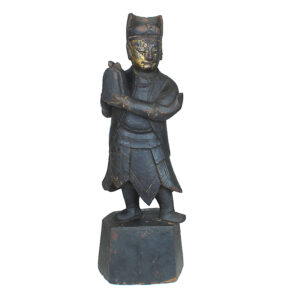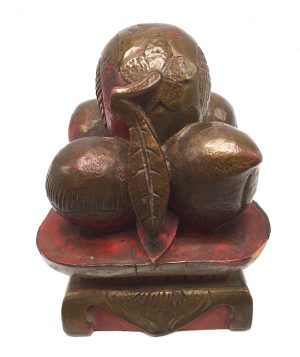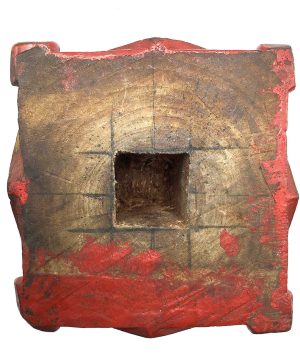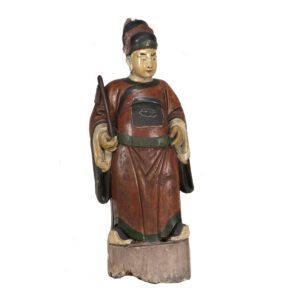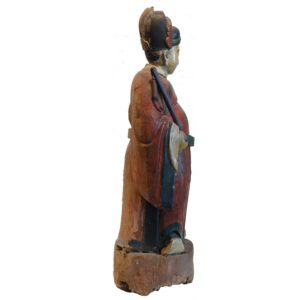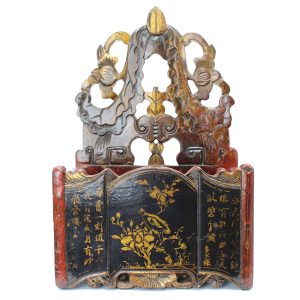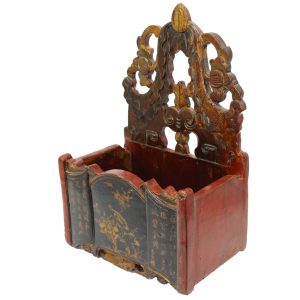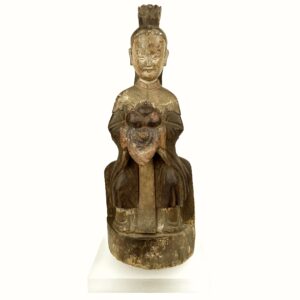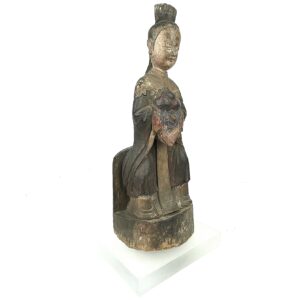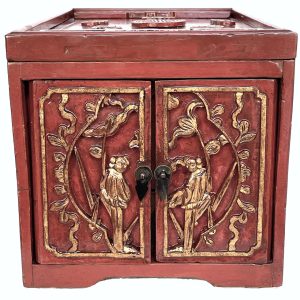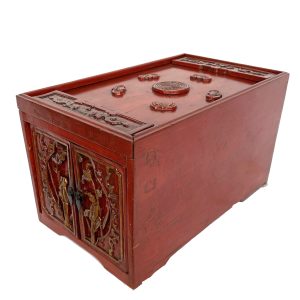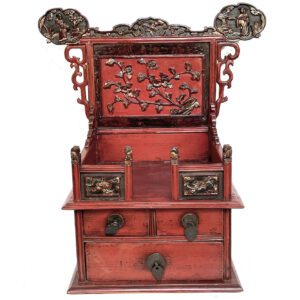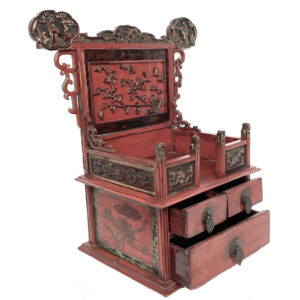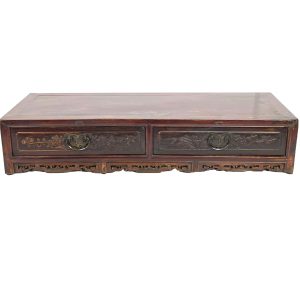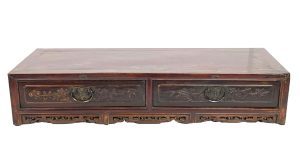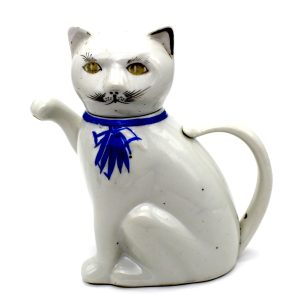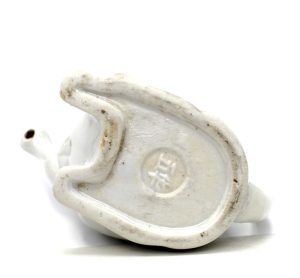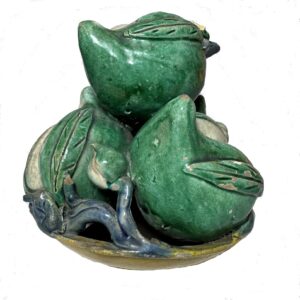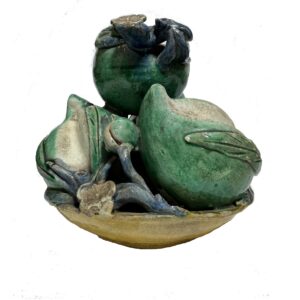Showing 1–12 of 28 results
-
Sale!


$435.00 Original price was: $435.00.$365.00Current price is: $365.00.
H: 15.5″. W: 5.5″. D: 4.24″ | FREE SHIPPING WITHIN CONTINENTAL U.S.
Taoist attendant holding an offerings tied with ribbons that symbolized longevity for generations. Some gilt and lacquer has naturally darkened from years age and incense.
-
Sale!


$225.00 Original price was: $225.00.$155.00Current price is: $155.00.
H: 4.75 ” Dia: 3.675 ” | FREE SHIPPING WITHIN CONTINENTAL U.S.
This carved food offering was an auspicious bed ornament to bring the lucky couple prosperity, health, a long life and many sons as the pomegranate symbolizes fertility, the peaches longevity. Carved offerings were often wedding gifts.
-
Sale!


$4,800.00 Original price was: $4,800.00.$3,750.00Current price is: $3,750.00.
H: 32″ W: 9″ D: 8″ | CALL 213-568-3030 OR EMAIL [email protected] FOR SHIPPING
Lu Donghin, most celebrated of 8 Taoist Chinese Immortals, rides on clouds with a 2-edged sword to cut through greed, lust, sorrow. Venerated in temples, grottoes, sacred mountains, he is associated with medicine, elixir of life and power over evil spirits. This 18th large figure with cloud design on chest.
-
Sale!


$350.00 Original price was: $350.00.$295.00Current price is: $295.00.
H: 10.75″ W: 7″ D: 4.5″ | CALL 213-568-3030 OR EMAIL [email protected] FOR SHIPPING.
The auspicious symbols on this charming document holder which are puns for “harmony and unity in marriage” indicate it was it was probably a wedding gift. And would serve that purpose admirably today as a decorative practical accessory and something you won’t find on a wedding registry.
-
Sale!


$595.00 Original price was: $595.00.$450.00Current price is: $450.00.
H: 15.5″ W: 7″ D: 4.5″ | FREE SHIPPING WITHIN CONTINENTAL U.S.
Reverent female Taoist attendant holding offering plate of 3 dumplings or fruits symbolizing 3 ancient gold or silver coins as a symbol of wealth and a wish for passing 3 imperial examination levels to assure the family’s status and financial stability.
-
Sale!


$385.00 Original price was: $385.00.$325.00Current price is: $325.00.
Ht: 8.5” W: 15” D: 9” | CALL 213-568-3030 OR EMAIL [email protected] FOR SHIPPING COST
Given the auspicious images on this finely crafted red and gilt jewelry box -a lotus and 5 bats surrounding a longevity roundel, it was probably a wedding gift for a fortunate couple as a wish for longevity, fertility, harmony and many and sons.
-
Sale!


$695.00 Original price was: $695.00.$495.00Current price is: $495.00.
Ht: 20.75” W: 19.125” D: 11” |CALL 213-568-3030 OR EMAIL [email protected] FOR SHIPPING COST
Fine ladies vanity cabinet covered with red lacquer and gold highlights. Parents’ gift to newlyweds with auspicious symbols for happiness, long life and having sons reflecting Confucian belief that producing sons to carry on the family name is essential to happiness.
-
Sale!


$595.00 Original price was: $595.00.$375.00Current price is: $375.00.
H: 5.625″ W: 27.875″ D: 9.75″ | CALL 213-568-3030 OR EMAIL [email protected] FOR SHIPPING
Charming antique low profile lacquered finished chest adds warmth to any setting. Drawers with carved auspicious symbols for the Five Happinesses include peonies, vines, butterflies, plum blossom and a Japanese lily. Inset panel with florals and decorative apron and brass butterfly handles.
-
Sale!


$650.00 Original price was: $650.00.$395.00Current price is: $395.00.
H: 7.75” W: 3.5″ D: 3.5″ | FREE SHIPPING within continental U.S.
Rare and charming carved attendant pair to flank deities on circular pedestals presenting boxed offerings with ribbons as wish for longevity.
-
Sale!


$145.00 Original price was: $145.00.$125.00Current price is: $125.00.
Ht: 6.25” W: 5.5” D: 3.25” | FREE SHIPPING WITHIN CONTINENTAL U.S.
The Chinese characters within a circled seal in the mold on the bottom indicate this teapot is an antique. As the thin ribbon blue collar as wishes for long life, it is a perfect birthday gift. Recommended for decorative use only.
-
Sale!


$450.00 Original price was: $450.00.$295.00Current price is: $295.00.
Ht: 5.5” Dia: 6” | FREE SHIPPING WITHIN CONTINENTAL U.S.
Shiwan stoneware peaches and lotuses on footed bowl auspicious symbols associated with springtime, fertility, long healthy life for many generations and therefore are propitious gifts for birthdays, especially for the elderly.
-
Sale!


$425.00 Original price was: $425.00.$310.00Current price is: $310.00.
Ht: 1.25″ W: 15″ D:14.87″ | CALL 213-568-3030 OR EMAIL [email protected] FOR SHIPPING COST
This intricately hand carved gold and silver platter with indentations on both sides was used to make confections called sweetmeats eaten at festivals, holidays, and other key celebrations. The round molds symbolize the moon and cohesion of the family. The 5-petal plum blossoms attached to vines symbolize purity and endurance, as well as the coming of spring, renewal, and longevity. The multiple seeds are a wish for fertility and sons, and thus this mold may have been a holiday and/or marriage gift to a young couple.
End of content
End of content

